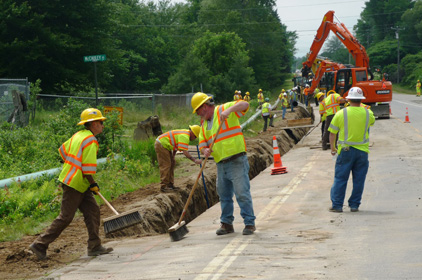Good Advice from American Petroleum Institute

|
| There is attention to security and safety details when laying pipes. Construction crews from Summit Natural Gas of Maine install a portion of the 130 miles of pipeline that will provide natural gas service for Augusta. Photo courtesy of Summit Natural Gas of Maine |
In order to assist petroleum companies evaluate and respond to security threats, the American
Petroleum Institute has:
- Assessed the general types of security risks to the public and to petroleum supplies that each sector may face due to terrorism;
- Identified existing standards, recommended practices, guidance and other operational practices, as well as ongoing initiatives that may mitigate these risks;
- Developed guidance on conducting security vulnerability assessments in the petroleum and petrochemical industries;
- Developed recommended practices for security for offshore oil and gas operations; and
- Worked with the Federal Government, other industry associations and petroleum companies to prepare and distribute appropriate guidance.
Examples of petroleum facility assets subject to potential security risk include:
- Buildings -- Administration offices, corporate offices, control rooms.
- Equipment -- Process units and associated control systems; product storage tanks; surge vessels, boilers, turbines, process heaters, sewer systems.
- Support systems -- Utilities such as natural gas lines, electrical power grid and facilities (including back-up power systems), water-supply systems, wastewater treatment facilities.
- Transportation interface -- Railroad lines and railcars, product loading racks and vehicles, pipelines entering and leaving facility, marine vessels and dock area, offsite storage areas.
- Cyber systems and information technology -- Computer systems, networks, all devices with remote maintenance ports, SCADA systems, laptops, PDAs and cell phones.
Looking for a reprint of this article?
From high-res PDFs to custom plaques, order your copy today!






